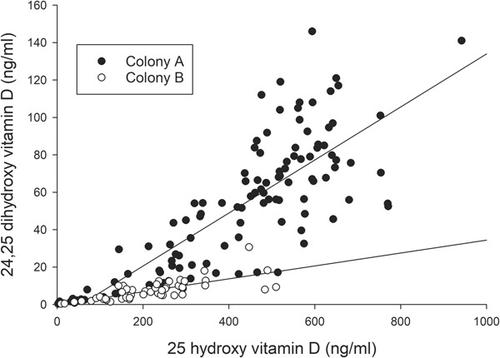当前位置:
X-MOL 学术
›
Am. J. Primatol.
›
论文详情
Our official English website, www.x-mol.net, welcomes your feedback! (Note: you will need to create a separate account there.)
Evaluation of vitamin D3 metabolites in Callithrix jacchus (common marmoset).
American Journal of Primatology ( IF 2.4 ) Pub Date : 2020-04-09 , DOI: 10.1002/ajp.23131 Anna E Goodroe 1 , Casey Fitz 2 , Michael L Power 3 , Ricki J Colman 2, 4 , Saverio Capuano 2 , Toni E Ziegler 2
American Journal of Primatology ( IF 2.4 ) Pub Date : 2020-04-09 , DOI: 10.1002/ajp.23131 Anna E Goodroe 1 , Casey Fitz 2 , Michael L Power 3 , Ricki J Colman 2, 4 , Saverio Capuano 2 , Toni E Ziegler 2
Affiliation

|
Vitamin D3 (cholecalciferol) is endogenously produced in the skin of primates when exposed to the appropriate wavelengths of ultraviolet light (UV-B). Common marmosets (Callithrix jacchus) maintained indoors require dietary provision of vitamin D3 due to lack of sunlight exposure. The minimum dietary vitamin D3 requirement and the maximum amount of vitamin D3 that can be metabolized by marmosets is unknown. Observations of metabolic bone disease and gastrointestinal malabsorption have led to wide variation in dietary vitamin D3 provision amongst research institutions, with resulting variation in circulating 25-hydroxyvitamin D3 (25(OH)D3 ), the accepted marker for vitamin D sufficiency/deficiency. Multiple studies have reported serum 25(OH)D3 in captive marmosets, but 25(OH)D3 is not the final product of vitamin D3 metabolism. In addition to serum 25(OH)D3, we measured the most physiologically active metabolite, 1,25-dihydroxyvitamin D3 (1,25(OH)2 D3 ), and the less well understood metabolite, 24,25-dihydroxyvitamin D3 (24,25(OH)2 D3 ) to characterize the marmoset's ability to metabolize dietary vitamin D3 . We present vitamin D3 metabolite and related serum chemistry value colony reference ranges in marmosets provided diets with 26,367 (Colony A, N = 113) or 8,888 (Colony B, N = 52) international units (IU) of dietary vitamin D3 per kilogram of dry matter. Colony A marmosets had higher serum 25(OH)D3 (426 ng/ml [SD 200] vs. 215 ng/ml [SD 113]) and 24,25(OH)2 D3 (53 ng/ml [SD 35] vs. 7 ng/ml [SD 5]). There was no difference in serum 1,25(OH)2 D3 between the colonies. Serum 1,25(OH)2 D3 increased and 25(OH)D3 decreased with age, but the effect was weak. Marmosets tightly regulate metabolism of dietary vitamin D3 into the active metabolite 1,25(OH)2 D3 ; excess 25(OH)D3 is metabolized into 24,25(OH)2 D3 . This ability explains the tolerance of high levels of dietary vitamin D3 by marmosets, however, our data suggest that these high dietary levels are not required.
中文翻译:

评价Callithrix jacchus(普通mar猴)中的维生素D3代谢产物。
当暴露于适当波长的紫外线(UV-B)中时,灵长类动物皮肤内源性产生维生素D3(胆钙化固醇)。由于缺乏阳光照射,在室内饲养的普通mar猴(Callithrix jacchus)需要饮食中提供维生素D3。mar猴可代谢的最低饮食维生素D3需求量和最大维生素D3量是未知的。代谢性骨病和胃肠道吸收不良的观察导致研究机构之间饮食中维生素D3的提供存在很大差异,导致循环中的25-羟基维生素D3(25(OH)D3)(维生素D充足/缺乏的公认标记)的变化。多项研究已报道圈养mar猴的血清25(OH)D3,但25(OH)D3不是维生素D3代谢的最终产物。除了血清25(OH)D3外,我们还测量了最具生理活性的代谢物1,25-二羟基维生素D3(1,25(OH)2 D3)和鲜为人知的代谢物24,25-二羟基维生素D3(24 ,25(OH)2 D3)来表征the猴代谢食物中维生素D3的能力。我们提供了在mos猴中提供的维生素D3代谢产物和相关的血清化学值菌落参考范围,这些饮食提供每千克干26,367(菌落A,N = 113)或8,888(菌落B,N = 52)国际单位(IU)日粮中的饮食维生素D3物。殖民地A mos猴的血清25(OH)D3(426 ng / ml [SD 200]比215 ng / ml [SD 113])和24,25(OH)2 D3(53 ng / ml [SD 35] vs 。7 ng / ml [SD 5])。菌落之间的血清1,25(OH)2 D3没有差异。血清1,25(OH)2 D3随年龄增加而增加,而25(OH)D3随年龄下降,但作用较弱。mos猴严格控制饮食中维生素D3代谢成活性代谢物1,25(OH)2 D3的代谢;过量的25(OH)D3代谢为24,25(OH)2 D3。这种能力解释了mos猴对高水平饮食维生素D3的耐受性,但是,我们的数据表明,这些高水平饮食不是必需的。
更新日期:2020-04-09
中文翻译:

评价Callithrix jacchus(普通mar猴)中的维生素D3代谢产物。
当暴露于适当波长的紫外线(UV-B)中时,灵长类动物皮肤内源性产生维生素D3(胆钙化固醇)。由于缺乏阳光照射,在室内饲养的普通mar猴(Callithrix jacchus)需要饮食中提供维生素D3。mar猴可代谢的最低饮食维生素D3需求量和最大维生素D3量是未知的。代谢性骨病和胃肠道吸收不良的观察导致研究机构之间饮食中维生素D3的提供存在很大差异,导致循环中的25-羟基维生素D3(25(OH)D3)(维生素D充足/缺乏的公认标记)的变化。多项研究已报道圈养mar猴的血清25(OH)D3,但25(OH)D3不是维生素D3代谢的最终产物。除了血清25(OH)D3外,我们还测量了最具生理活性的代谢物1,25-二羟基维生素D3(1,25(OH)2 D3)和鲜为人知的代谢物24,25-二羟基维生素D3(24 ,25(OH)2 D3)来表征the猴代谢食物中维生素D3的能力。我们提供了在mos猴中提供的维生素D3代谢产物和相关的血清化学值菌落参考范围,这些饮食提供每千克干26,367(菌落A,N = 113)或8,888(菌落B,N = 52)国际单位(IU)日粮中的饮食维生素D3物。殖民地A mos猴的血清25(OH)D3(426 ng / ml [SD 200]比215 ng / ml [SD 113])和24,25(OH)2 D3(53 ng / ml [SD 35] vs 。7 ng / ml [SD 5])。菌落之间的血清1,25(OH)2 D3没有差异。血清1,25(OH)2 D3随年龄增加而增加,而25(OH)D3随年龄下降,但作用较弱。mos猴严格控制饮食中维生素D3代谢成活性代谢物1,25(OH)2 D3的代谢;过量的25(OH)D3代谢为24,25(OH)2 D3。这种能力解释了mos猴对高水平饮食维生素D3的耐受性,但是,我们的数据表明,这些高水平饮食不是必需的。


























 京公网安备 11010802027423号
京公网安备 11010802027423号